Effective Strategies to Deter Pileated Woodpeckers
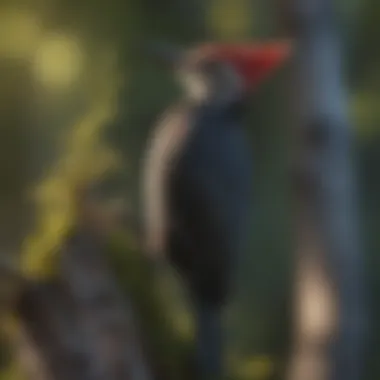
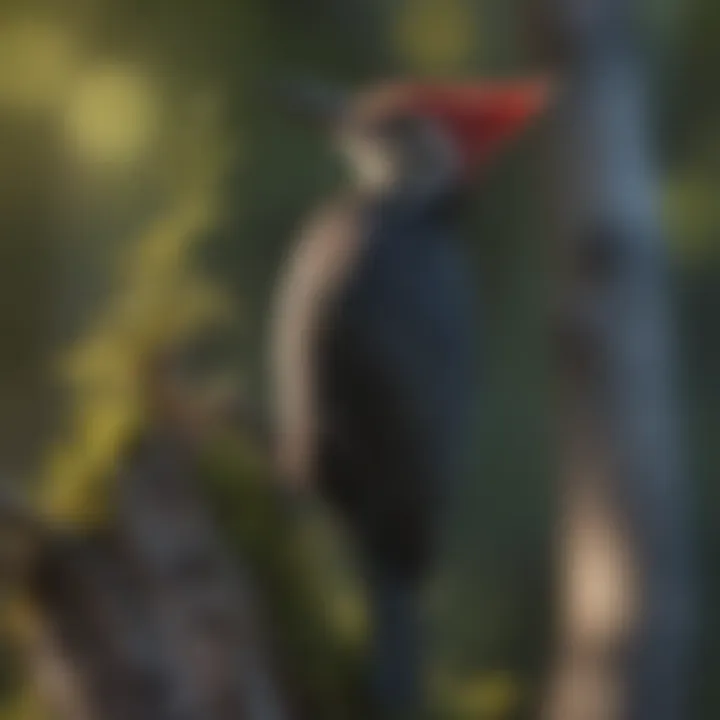
Intro
Pileated woodpeckers are both fascinating and challenging for homeowners and housewives alike. Their impressive size and noise can add a unique aspect to one’s living environment, yet their persistent drilling can cause significant damage. Understanding how to deter these birds effectively requires knowledge of their behavior and habits. The following sections will explore various strategies, focusing on both prevention and control, to keep your home safe from these diligent creatures.
Understanding the Pest
Identification
Pileated woodpeckers are easily identifiable by their striking appearance. They are large birds, approximately 16 to 19 inches in length, with a prominent red crest on their heads. Their black bodies have white stripes down the neck and face, making them visually distinct. They are often heard before they are seen, as their loud calls echo through forested areas. For homeowners, recognizing these features is the first step in managing their presence.
Life Cycle
The life cycle of pileated woodpeckers involves several stages. Typically, they excavate large rectangular holes for nesting in dead or decaying trees. The breeding season begins in spring, where females lay two to five eggs. The young are altricial, meaning they depend on their parents for food and care. They stay in the nest for about 30 days before fledging, which means they are capable of flight. Understanding this cycle helps to determine when woodpecker disturbances may peak in your area.
Pest Prevention Strategies
Environment Modification
Altering the environment can greatly reduce the attraction of pileated woodpeckers to your property. Here are some principles to consider:
- Remove Dead Trees: Eliminate dead or dying trees, as these provide ideal nesting and foraging sites.
- Limit Food Sources: Pileated woodpeckers are attracted to places with abundant insect populations. Regular yard maintenance can minimize these food sources.
- Plant Deciduous Trees Wisely: While woodpeckers are drawn to certain trees, consider planting species that are less appealing to them, such as pines.
Physical Barriers
Installing physical barriers can effectively deter pileated woodpeckers. Options include:
- Netting: Bird netting can create a barrier around trees or areas where these birds frequently feed.
- Visual Deterrents: Hanging items like aluminum foil strips or reflective tape can create movement and light reflections that scare away woodpeckers.
Control Methods
Chemical Control
Chemical controls should be considered a last resort. Various repellents may deter woodpeckers from certain areas when applied correctly. These products, often made from natural ingredients, can discourage woodpecker activity. However, it's essential to choose options that have minimal impact on the environment and other wildlife.
Biological Control
Biological control involves the use of natural predators or other ecological methods to manage woodpecker populations. Introducing specific bird species that prey on woodboring insect larvae could indirectly reduce woodpecker interest in your property. It's crucial to research and choose non-invasive species that are compatible with local wildlife.
Effective strategies for mitigating the impact of pileated woodpeckers focus on both prevention and control, ensuring a balanced approach to maintaining your environment.
Ending
Detering pileated woodpeckers necessitates a combination of awareness, prevention, and control strategies. By understanding their behavior and ecology, homeowners can create environments less conducive to these birds, while taking responsible measures to protect their property. In doing so, one not only safeguards their property but also respects the natural behaviors of these unique avian creatures.
Understanding Pileated Woodpeckers
Understanding pileated woodpeckers is crucial for effectively managing their presence in residential areas. These birds, known for their striking appearance and unique behaviors, can cause various issues if they find suitable habitats around homes. Recognizing their characteristics, preferences, and habits allows homeowners to develop tailored strategies to deter them. It is essential to appreciate how their ecological roles influence local environments, thus providing insight into appropriate responses without harming the species.
General Characteristics
Pileated woodpeckers are among the largest woodpecker species in North America. They measure about 16 to 19 inches in length, with a wingspan that can exceed 26 inches. Their plumage is predominantly black with white stripes on the face and neck, and their bright red crest is a distinctive feature. Males and females are similar in appearance, making it difficult for casual observers to differentiate them.
In terms of behavior, these woodpeckers are known for their loud calls and drumming. The drumming serves multiple purposes, including establishing territory and attracting mates. The sound can be quite resonant, often echoing in wooded areas. Understanding their physical traits is not just about identification; it is fundamental in realizing their habits and behavioral patterns, paving the way for effective management strategies.
Habitat Preferences
Pileated woodpeckers thrive in mature forests but can adapt to various environments, including suburban areas. They prefer areas with large trees, as these provide ideal nesting sites and abundant food sources. These birds actively seek out decaying and dead trees, as they are rich in insects such as wood borers and ants, which are staple components of their diets.
Their preference for large trees means that any landscape that has an abundance of dying or damaged wood can attract them. Homeowners with extensive gardens or trees in their yards may inadvertently create a hospitable environment for these birds. Recognizing the aspects of your garden that may appeal to pileated woodpeckers can help in devising effective preventive measures.
Dietary Habits
The diet of pileated woodpeckers mainly consists of insects. They are particularly adept at extracting ants and beetles from wood. Their foraging techniques involve chiseling into trees, creating large rectangular holes that are easily identifiable. This behavior can present challenges for homeowners, particularly when it leads to structural damage in trees and wooden structures.
Apart from insects, they also consume fruits and nuts, which are seasonal components of their diet. Understanding their feeding habits is critical. Knowing what attracts them can help in minimizing food sources that lead to their presence around residential areas.
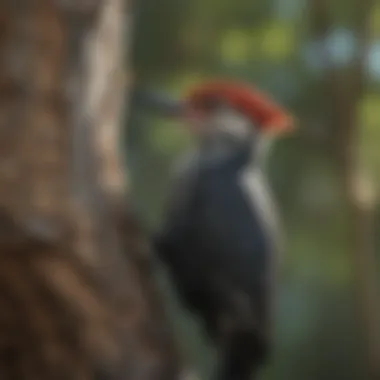
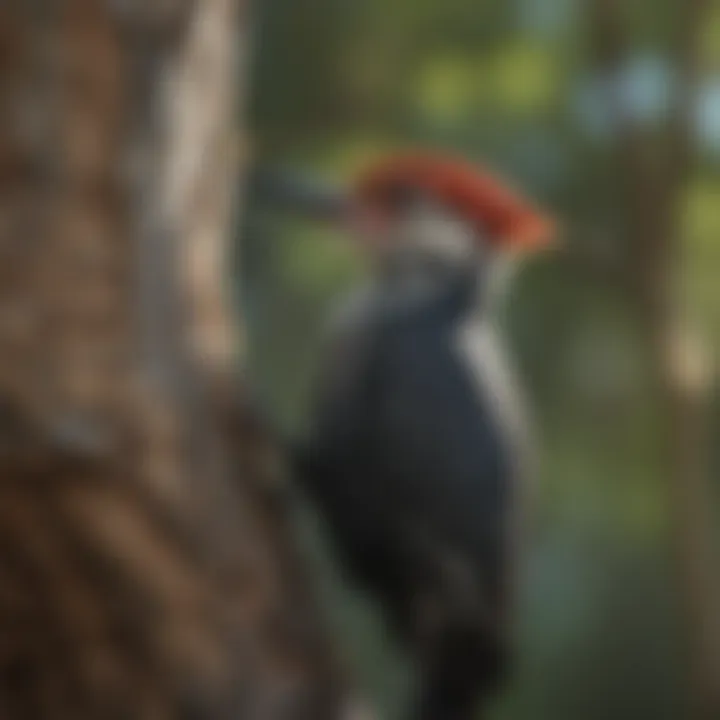
Behavioral Patterns
Behaviorally, pileated woodpeckers are both solitary and social creatures. While males and females form breeding pairs, they often forage alone. During spring and summer, their activities increase, which coincides with nesting. Their drumming and calling can be heard frequently during these months, making this period a peak time for human interaction with them.
They are also territorial; males will defend their area vigorously from other males. This territorial behavior can lead to significant noise and, at times, damage to property. Observing their patterns enables homeowners to anticipate potential issues, guiding the selection of effective deterrent strategies. By understanding these behavioral traits, it becomes easier to implement measures that will disrupt their activities without causing harm.
The Impact of Pileated Woodpeckers
The influence of pileated woodpeckers on both the environment and human structures cannot be overstated. Understanding this impact allows homeowners and ecologists to better manage their surroundings, promoting ecological balance while minimizing potential damage. The significance of pileated woodpeckers lies in their role within the ecosystem and the challenges they present.
Ecological Importance
Pileated woodpeckers serve a critical function in forest ecosystems. They help control insect populations, particularly wood-boring beetles, which can otherwise damage trees. By foraging within tree bark for their food, they inadvertently create cavities that serve as nests for other birds and mammals. This behavior highlights their role as ecosystem engineers, fostering biodiversity. Their presence often indicates a healthy forest, as these birds typically thrive in areas with sufficient dead or decaying wood that hosts their preferred beetle species.
Potential Damage
Despite their ecological benefits, pileated woodpeckers can cause significant concerns for homeowners and urban environments. The damage they inflict can be categorized primarily into two areas: structural damage and tree health concerns.
Structural Damage
Structural damage refers to the harm caused to buildings, fences, and other man-made structures. Pileated woodpeckers can perforate wooden siding, doors, or window frames, seeking insects that may have made their home there. The key characteristic of this type of damage is its potential to compromise the integrity of structures. Homeowners often find that such damage requires immediate attention. Ignoring these symptoms may lead to costly repairs. It is essential to recognize that while the woodpecker is not intentionally harming the structure, their foraging behavior results in unintended consequences. The unique feature of structural damage includes the reality that repairs can involve both aesthetic and foundational issues. The disadvantage can manifest as a financial burden indicated by the need for replacement or extensive repairs.
Tree Health Concerns
Health concerns regarding trees caused by pileated woodpeckers extend beyond mere cosmetic damage. When these birds peck at trees, they can introduce diseases and weaken the trees, leading to a decline in their vitality. The key characteristic here is that the damage often affects living trees, which could be a focal point in a landscape or a habitat for wildlife. Addressing tree health is crucial because it impacts the entire ecosystem. When a tree is compromised, it not only affects itself but also other dependent species and even the local climate. Moreover, the unique feature of tree health concerns lies in the long-term effects that may not be immediately visible. These concerns might lead to the loss of shade, aesthetic beauty, or even necessary habitat for other species over time. Disadvantages of failing to manage this can result in reduced property value or even increased pest problems as less healthy trees attract different pests.
"Recognition of both ecological and structural impacts from pileated woodpeckers is vital for maintaining balance in our environments."
Understanding these impacts facilitated by pileated woodpeckers not only informs effective strategies for deterrence but also emphasizes the need for careful consideration before taking drastic measures against them.
Identifying Woodpecker Damage
Identifying woodpecker damage is crucial for homeowners to take effective action against these birds. Pileated woodpeckers, known for their loud drilling and distinctive markings, can cause significant harm to wooden structures and trees. The sooner you can recognize the signs of their activity, the easier it becomes to implement preventive measures or consult professionals when needed.
Signs of Infestation
Several indicators can reveal the presence of pileated woodpeckers. These signs help homeowners assess the extent of damage and determine proper responses. Common signs include:
- Drilling Holes: Look for large, rectangular holes in trees or wooden structures. These often measure around 2-3 inches wide.
- Chips and Shavings: Finding wood chips on the ground can be a clear sign that woodpeckers are active in the area.
- Sounds: Listen for the characteristic knocking sound made by woodpeckers. It can signal nearby infestation.
- Staining: Damage to trees may lead to staining from sap. This indicates that the wood is being hollowed out.
Recognizing these signs early can help minimize damage to your home or landscape.
Differentiating from Other Birds
It is important to distinguish pileated woodpeckers from other species to ensure proper identification of damage. Several features can help differentiate them:
- Size and Coloration: Pileated woodpeckers are larger than most woodpeckers, measuring about 16-19 inches in length. Their striking black body, white neck, and red crest make them quite recognizable.
- Drilling Patterns: The drilling holes of pileated woodpeckers are larger and more rectangular compared to smaller woodpecker species that tend to make smaller, round holes.
- Behavior: Pileated woodpeckers are known for their energetic drumming and can be seen foraging on the ground for insects, making them distinctive in behavior from others.
With these details, homeowners can effectively identify any signs of infestation and differentiate pileated woodpeckers from more benign birds. This understanding is a cornerstone for further damage management and ecological diligence.
Preventive Measures
Preventive measures are essential in managing interactions with pileated woodpeckers. These birds are known for their relentless drilling, which can cause significant damage to structures and trees. Addressing the issue before it escalates can save homeowners time and cost in repairs. Preventive measures primarily focus on making environments less appealing to these birds. By altering their surroundings, it is more feasible to deter their presence effectively.
Creating Less Appealing Environments
Creating less appealing environments is a proactive strategy that targets the fundamental reasons that attract pileated woodpeckers to an area.
Removing Food Sources
Removing food sources is a key step in deterring pileated woodpeckers. These birds primarily feed on insects in dead or dying trees, therefore, eliminating anything that attracts them is vital. This approach involves inspecting trees and landscapes and addressing any signs of insect infestations. Regular tree maintenance will minimize the availability of food that is desired by woodpeckers.
The key characteristic of removing food sources is its direct impact on the woodpeckers' food supply. This method is beneficial because it does not require physical barriers and can be implemented relatively easily by homeowners.
Moreover, this approach is eco-friendly since it promotes tree health. However, it can take some time for woodpeckers to adjust to the change, thus patience is important. Removing food sources is, overall, a strategic choice when it comes to long-term management.
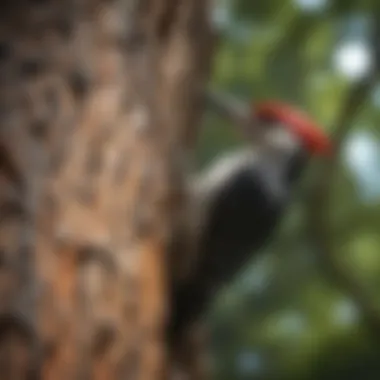
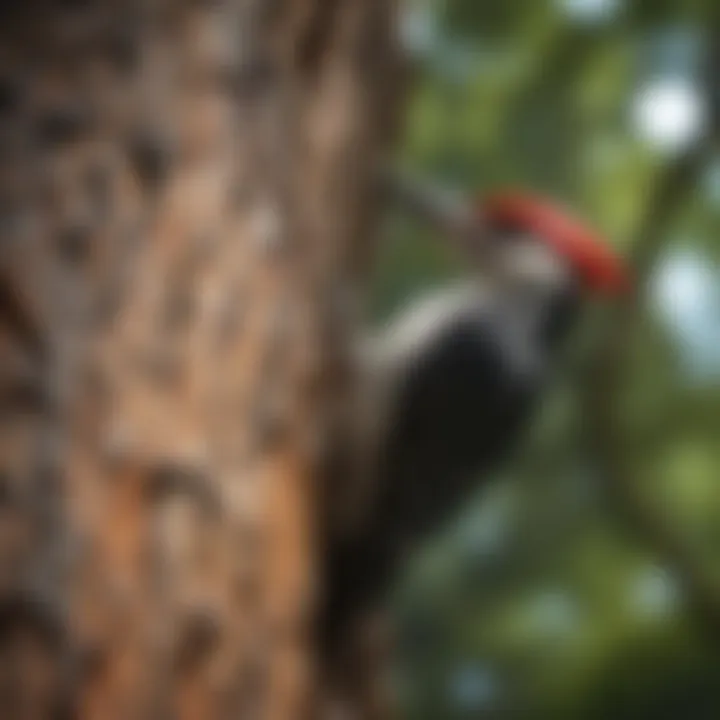
Repairing Structural Damage
Repairing structural damage is another critical preventive measure to address the issues caused by pileated woodpeckers. If a woodpecker has already started to drill into a building, immediate repairs are necessary to prevent further damage. This approach can involve filling holes or replacing damaged sections of wood.
The key characteristic of repairing structural damage is that it eliminates existing vulnerabilities which woodpeckers find attractive. This measure is crucial for homeowners as it preserve property value and reduces the risk of more severe damage occurring over time.
Furthermore, this approach can be seen as a beneficial choice for maintaining the aesthetics and functionality of a home. However, repair can be a higher initial cost, and it does require skilled labor for proper repairs. Therefore, homeowners need to weigh the immediate costs against future potential damage to make an informed decision.
Physical Barriers
Physical barriers play a significant role in deterring pileated woodpeckers when preventive measures are insufficient. These solutions physically restrict access to areas where woodpeckers may cause damage.
Netting and Screens
Netting and screens are an effective way to protect buildings and trees from woodpecker activity. These barriers can be placed around vulnerable structures or individual trees to form a protective shield against pecking. The primary advantage of netting is its visibility, which helps dissuade woodpeckers from approaching. This strategy is increasingly popular among homeowners looking to maintain their property without harming the birds.
The unique feature of netting is its adaptability. Homeowners can customize the size and shape of the netting according to their needs. However, proper installation is crucial. If not done correctly, gaps may still allow access, so careful attention is needed.
Woodpecker Deterrent Devices
Woodpecker deterrent devices are also a viable approach to keep pileated woodpeckers at bay. These devices often use loud noises or flashing lights to scare off woodpeckers. Many homeowners appreciate these devices because they can be easily installed and removed as needed.
The key characteristic of these devices is their immediate impact; once set up, they can provide almost instant results in warding off woodpeckers. However, continuous noise can lead to desensitization, requiring alternative tactics to ensure long-term deterrence. Homeowners should also consider the impact such devices may have on other wildlife.
Using a combination of these preventive strategies enhances overall effectiveness. By removing food sources, repairing structures, and implementing physical barriers, homeowners can significantly reduce the likelihood of pileated woodpecker infestations.
Reactive Strategies
In instances where preventive measures have not successfully kept pileated woodpeckers at bay, employing reactive strategies becomes essential. Reactive strategies refer to the actions taken after woodpeckers have already begun causing issues. Understanding the importance of these strategies is vital for homeowners who find themselves facing the challenges posed by these birds.
These approaches allow for immediate intervention, which can mitigate damage more efficiently. Moreover, they are particularly useful in urban environments where woodpecker activity can escalate quickly. By focusing on sound deterrents and visual scare tactics, homeowners can address the presence of pileated woodpeckers directly, aiming to shift their behavior and preferences away from problematic areas.
Sound Deterrents
Sound deterrents utilize auditory stimuli to discourage pileated woodpeckers from frequenting specific locations. The idea is to create an environment that is unpleasant to the birds, causing them to seek out quieter and safer spaces. Here are some effective sound deterrent strategies:
- Ultrasonic Devices: These devices emit high-frequency sounds that are inaudible to humans but can annoy woodpeckers. They are easy to install and can cover a significant area.
- Recording Playback: Playing back sounds of predators, like hawks or owls, can be effective in deterring woodpeckers. The sound of distress calls of other birds can also discourage them from approaching.
- Regular Noises: Setting up noise-making devices, such as wind chimes or bells, can create an unpredictable sound environment, making it less attractive for woodpeckers to stay.
Using sound deterrents may require some trial and error, as different methods may work better in varying environments.
Visual Scare Tactics
Visual scare tactics deploy sight-based strategies to repel pileated woodpeckers. Birds are generally cautious creatures, and using visual deterrents can tap into their natural instincts for survival. Some effective strategies include:
- Reflective Objects: Hanging shiny objects, such as aluminum foil strips or reflective tape can dissuade birds. The reflections can confuse and frighten them away.
- Bird Silhouettes: Placing decoys of predator birds, or even fake owls, can signal danger to woodpeckers. However, it’s important to move these decoys around frequently so the woodpeckers do not become accustomed to them.
- Banners and Flags: Brightly colored banners or flags that move with the wind can catch the attention of woodpeckers, making an area look less safe for nesting or feeding.
Eco-Friendly Approaches
Addressing the issues posed by pileated woodpeckers necessitates a thoughtful approach, especially when considering eco-friendly methods. These methods focus on deterrence rather than harm, prioritizing the well-being of the birds and the environment. Eco-friendly approaches yield several benefits, including the protection of local ecosystems, promotion of biodiversity, and avoidance of chemical pollutants that can affect other wildlife and humans.
Adopting eco-friendly strategies often relies on understanding the natural behaviors and preferences of pileated woodpeckers. By doing so, one can create a less inviting environment for them while also enhancing the habitat of beneficial species. This can be both effective and harmonizing with the surrounding nature.
Natural Deterrents
Natural deterrents are methods that utilize non-toxic substances or elements to make an area less attractive to pileated woodpeckers. Some examples include:
- Planting Non-Favored Trees: Pileated woodpeckers prefer certain types of trees for foraging. By planting species they tend to avoid, like certain hardwoods or less damaged trees, homeowners can discourage visits.
- Using Plants with Strong Scents: Certain herbs and plants, such as lavender or mint, may repel woodpeckers. Integrating these plants around your property can serve as a natural barrier.
- Reflective Surfaces: Installing reflective materials, like old CDs or reflective tape, can disrupt the birds' comfort level, pushing them to seek more welcoming spaces.
These natural methods not only deter woodpeckers but also support a balanced ecosystem that includes various forms of wildlife.
Encouraging Beneficial Insects
Another effective eco-friendly tactic is to promote beneficial insects that can create a balanced environment and reduce woodpecker attraction. Consider the following strategies:
- Creating Bug Hotels: Construct habitats for insects such as ladybugs and lacewings. These insects help control pest populations that may attract woodpeckers.
- Diverse Planting: Cultivating a variety of plants can draw beneficial insects to your yard. Native flowers, shrubs, and herbs are particularly effective.
- Minimizing Pesticide Use: Limiting or completely abstaining from chemical pesticides helps preserve the insect population that can deter the woodpeckers.
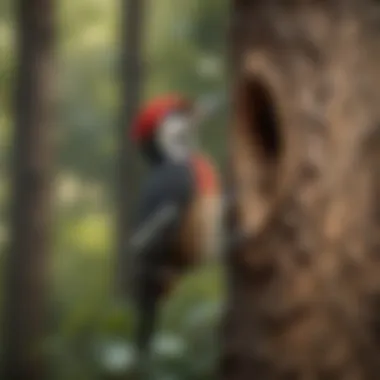
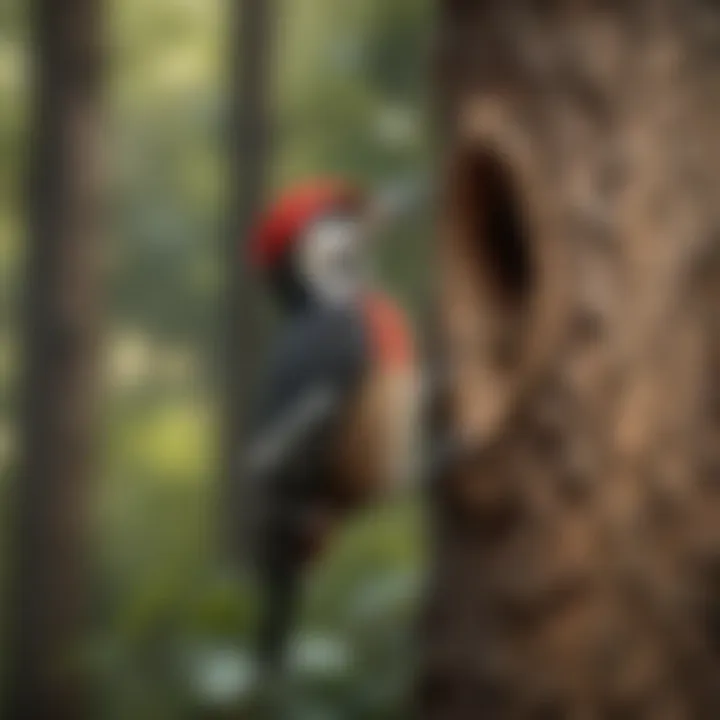
Encouraging a healthy insect population not only enhances biodiversity but also creates a natural check on pests that woodpeckers might otherwise target.
By employing these eco-friendly approaches, one can create an environment that not only discourages pileated woodpeckers but also enriches the local ecosystem.
When to Seek Professional Help
In situations where pileated woodpeckers create significant disturbances, it may become necessary to seek professional assistance. Understanding when to call in experts is crucial for effectively managing infestations. Not all woodpecker activities warrant external intervention, but certain signs indicate serious problems that require specialized knowledge and tools.
Recognizing the severity of the infestation is the first step. Signs of damage can range from superficial pecking marks to deep gouges in wood. Homeowners need to differentiate between routine woodpecker activities and those that pose real threats to structural integrity or tree health.
Benefits of Seeking Professional Help:
- Expert Assessment: Professionals can assess the situation accurately, determining the extent of the damage and the best course of action.
- Effective Techniques: They have access to specialized tools and methods that may not be available to the average homeowner.
- Peace of Mind: Engaging certified experts can alleviate stress and concerns about dealing with persistent woodpecker problems.
Considering these factors helps homeowners make informed decisions about pest management. Ignoring severe infestations might lead to costly repairs in the future.
Recognizing Severity of Infestation
To evaluate if a site requires professional intervention, homeowners must identify various signs of infestation. Pileated woodpeckers tend to create larger holes than other woodpecker species. Damage can significantly affect siding, wooden structures, and trees. Observe the following indicators:
- Extensive Drilling: Large, rectangular holes or deep groves are clear signs of pileated woodpecker presence.
- Multiple Entry Points: Finding numerous areas of damage indicates a serious issue that warrants attention.
- Ongoing Activity: Continuous pecking, especially during breeding seasons, suggests an established population.
- Other Wildlife: If other species or insects become associated with damage, it may signify broader ecological concerns.
Addressing these indicators promptly can prevent long-term issues and increase the chances of protecting your property.
Finding Certified Pest Control Services
If the assessment reveals severe damage or infestation, finding certified pest control services becomes the next logical step. The expertise of professionals ensures that interventions are not only effective but also responsible regarding ecological impacts.
When searching for these services, consider the following aspects:
- Certifications and Credentials: Check for licenses and certifications that demonstrate expertise in handling avian pest control.
- Experience and Reviews: Seek companies with a good reputation in your area. Online reviews on platforms like Reddit or Facebook can provide insight.
- Eco-Friendly Practices: Ensure the company uses humane and eco-conscious methods to manage woodpecker populations, respecting their ecological role.
- Consultation Options: Many services offer initial assessments. This can provide insight into their strategies before commitment.
Finding the right professional service ensures a balanced approach to pest management, minimizing damage while respecting the environment.
Case Studies
Successful Deterrent Implementations
In various locales, homeowners have managed to deter pileated woodpeckers using a range of strategies. One successful case involved the use of physical barriers. A homeowner in Wisconsin faced constant drilling on the exterior of their house. They decided to install metal flashing on the areas most affected. This barrier not only protected their home but also made the surfaces less appealing for the woodpeckers. The implementation led to a noticeable decrease in woodpecker activity, as they seemed to abandon the site in favor of more suitable environments.
Another effective method was documented in a suburban area of California. Residents employed visual deterrents by hanging shiny objects like aluminum foil strips and old CDs around their properties. The reflected light acted as a deterrent, startling the birds and interrupting their foraging behavior.
These anecdotal successes demonstrate that simple modifications can lead to effective deterrence when addressing the challenges posed by pileated woodpeckers.
Lessons Learned from Failures
While successes offer valuable insights, failures also present critical lessons. One homeowner tried to utilize sound deterrents, such as commercially available ultrasonic devices. Despite the initial optimism, the device did not yield the desired results. Instead, the woodpeckers continued their drilling, leading the homeowner to seek alternative methods. This case highlights the importance of understanding the limitations of specific approaches and ensuring that strategies align with the particular behaviors of the woodpecker.
Moreover, a property owner installed elaborate visual scare tactics, including owl decoys. Initially, this seemed promising. However, over time, the woodpeckers became accustomed to the presence of these decoys, and the effectiveness diminished. This situation underscores the need for regularly changing tactics and alternating methods to avoid habituation in woodpecker behavior.
In summary, case studies are invaluable. They showcase both successful implementations and cautionary tales that can guide homeowners in their quest to deter pileated woodpeckers. By analyzing these instances, it becomes clearer that an adaptive and informed approach is critical for effective pest management.
Concluding Thoughts
The importance of concluding thoughts in this article cannot be overstated. This section serves as a synthesis of the strategies discussed, emphasizing the practical implications for households dealing with pileated woodpeckers. By organizing key takeaways, this part aims to provide readers with a clear action plan tailored to their unique situations.
Reflecting on Effective Strategies
In understanding how to deter pileated woodpeckers, it’s essential to reflect on the effectiveness of different methods. Several strategies have been highlighted, including preventive measures such as creating less appealing environments and the use of physical barriers. Each strategy must be evaluated based on its applicability and success rate in real scenarios.
For example, homeowners should assess the potential of using visual scare tactics alongside natural deterrents. Observations from case studies reveal that a combined approach often yields the best results. These findings suggest that while certain deterrents may exhibit effectiveness in isolation, the interplay between strategies can enhance overall performance.
Consider these effective strategies as a toolkit, where each method has its own strengths and weaknesses. Regular monitoring and assessments can help homeowners adjust their tactics based on woodpecker activity levels. Continual reflection on what works and what fails allows for informed decision-making in dealing with these birds.
Emphasizing Eco-Conscious Methods
Emphasizing eco-conscious methods in the management of pileated woodpecker populations is crucial. It aligns with the broader environmental goal of minimizing harm to non-target species and preserving the balance of local ecosystems. Using natural deterrents, such as specific plants that repel these woodpeckers, can be advantageous not only for pest management but also for promoting biodiversity.
Practicing eco-friendly approaches has numerous benefits:
- Sustainable Solutions: Incorporating non-toxic methods reduces the risk of harming other wildlife, pets, and even human inhabitants.
- Enhancing Landscape Aesthetics: Plants used as natural deterrents often have additional benefits, such as improving the aesthetic appeal of gardens while serving a dual purpose.
- Long-Term Viability: Many eco-conscious methods require less frequent re-implementation, making them more cost-effective over time.
In summary, eco-conscious methods provide a holistic solution that aligns with a greater commitment to environmental stewardship. By prioritizing these strategies, homeowners can deter pileated woodpeckers while ensuring the integrity of their living spaces and surrounding ecosystems.







